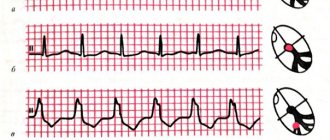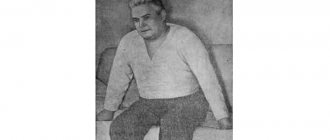Heart failure and vegetative-vascular dystonia
Home -> Other diseases -> Heart failure and vegetative-vascular dystonia
Dear reader, if you carefully read the information on this site, you should understand that any disease, especially a chronic disease, has symptoms of VSD! Anyone, and this applies to both acute and chronic heart failure.
It is the heart, as one of the most important organs in the body, that forces a person to constantly listen to its work, periodically count the pulse, and measure blood pressure.
It is heart failure that requires its owner to use life-saving medications and periodically visit the attending physician.
Heart failure, like other diseases, turns a person’s thoughts into panic-anxious ones, forcing him to be more depressed, thinking at this time not only about the meaning of life, but also death.
Heart failure, and especially chronic failure, forms the dominants of both VSD and heart failure, which means complete dependence of one on the other.
In heart failure, VSD is added to the main symptoms of the disease, which declares itself as VSD of the cardiac type .
Can VSD cause heart failure? Of course not! For heart failure means that the heart muscle is not able to function in the mode determined by Mother Nature. And with VSD, the functionality of the myocardium does not suffer: the heart works in the proper mode without any organic changes in it.
Although heart failure as a pathology can become a companion to many diseases, but not VSD! And therefore, when solving a heart problem in any specific case, one must begin to proceed from the cause of heart failure.
Heart failure, regardless of the causes of its occurrence, can be either acute, developing in a matter of hours or even minutes, or chronic, developing gradually over a long time.
In acute forms of heart failure, the patient needs emergency care. That is, this is a state when they say that delay is like death! This form of heart failure accompanies myocardial infarction, pulmonary embolism, heart injury, etc., in which severe shortness of breath occurs, moist rales occur in the lungs, and dizziness reaches its peak.
Of course, there is no analogy here with VSD of the cardiac type, because with VSD, as a disease-condition, there are no organic changes in the heart.
Dominant heart failure, like dominant VSD, does not yet exist in this case, but they will certainly arise as soon as the patient recovers from the acute condition. That is, when the energy of thoughts acquires the character of panic-anxious thoughts.
But before acute heart failure occurs, a person may suffer from VSD, and this problem, of course, leaves its mark on recovery after the tragedy: the person becomes capricious, suspicious, often whiny, confident that today is his last.
His panicky and anxious thoughts reveal a real fear of death, which he can often subdue with great difficulty.
In chronic heart failure, the patient's condition is relatively stable, the symptoms of the disease increase gradually. A person is worried about weakness, palpitations, dry cough, shortness of breath, swelling.
Menopause and VSD in men
Menopause in men occurs at the age of 49-55 years. By this period, men begin to actively produce the female hormone, and testosterone, on the contrary, reduces its production. In the normal course of the disease, menopause in the male half of humanity passes without visible changes, except for reproductive function. In the case of exacerbation, as in women, VSD, psychoneurological disorders, increased tearfulness, depression, absent-mindedness and concentration, as well as sexual disorders are observed.
In this situation, treatment of exacerbations of the disease is carried out by an andrologist - a doctor specialist in this field. The patient is prescribed medications aimed at solving the underlying problem, as well as hormonal therapy, vitamin therapy, physiotherapeutic measures, antidepressants and, in rare cases, tranquilizers. The latter of which improve and restore metabolism and microcirculation of substances in the cells of the cerebral cortex.
The consequences of the disease, in most cases, are positive, but restoration of sexual function is observed only in a third of patients.
Symptoms of vegetative-vascular dystonia
If we talk about the symptoms of VSD, then it seems that every person will be able to detect something in themselves, they are so multifaceted. It is only important to understand that these are symptoms of vegetative vascular dystonia , and not some other disease.
Let us consider in more detail the manifestations of vegetative-vascular dystonia:
- You may have heart pain, rapid heartbeat even at rest, strong but not necessarily rapid heartbeat, a feeling of irregular heartbeat, and even chest pain.
The sensations are unpleasant and frightening, so it is imperative to carry out all types of diagnostics to determine the condition of the heart and exclude other serious heart diseases. The heart is one and its health must be approached thoroughly.
- Unstable blood pressure, which can be either high or low. It is also possible for a person to have only high blood pressure, which is more typical for obese people, or low blood pressure, which is more typical for more slender people.
In any case, it doesn’t hurt to check your blood pressure, because elevated blood pressure numbers lead to changes in internal organs, primarily the heart, and are also fraught with serious illnesses, heart attacks and strokes.
- Symptoms of the respiratory tract - frequent and short breaths (fast, shallow breathing), unsatisfied inhalation, when you want to take a deep breath, but you can’t, a feeling of lack of air.
I feel an unsatisfied breath and short, rapid breathing.
- Temperature symptoms - body temperature can be either increased or decreased, dropping down to 35°C.
It’s much more interesting when the temperature rises in the evening, you think everyone is sick, but no, the next morning there is no temperature. This was a symptom of vegetative-vascular dystonia.
- Increased fatigue even with little exertion, feeling groggy in the morning even with sufficient sleep, lethargy, difficulty concentrating, drowsiness.
- Feelings of anxiety, internal tension, increased tone, panic attacks, feelings of fear.
These manifestations significantly worsen the quality of life and over time, although you partially get used to them, you have enormous willpower to endure them.
- Digestive symptoms of vegetative vascular dystonia are pain in the abdomen, a tendency to constipation, loose stools, and a feeling of nausea. vomiting when overeating.
- Genitourinary symptoms - frequent urge to urinate, lack of orgasms with normal sexual desire, occasional pain when urinating.
- Intolerance to heat or cold, cold extremities, marbled skin tone of the extremities, persistent dark circles under the eyes, pain in the legs, headaches, dizziness, tendency to faint.
Symptoms of vegetative-vascular dystonia are also conventionally divided into:
- vagotonia;
- sympathicotonia;
- neurocirculatory dystonia.
It is definitely worth saying that in certain cases, the symptoms of VSD can take on the nature of crises. This is the finish line! The first case is vagoinsular crises, in which a person’s body temperature and blood pressure may drop sharply. It may break through later. Abdominal pain, heart pain, nausea, vomiting will complete the sad picture.
Definition of disease. Causes of the disease
From the editor: vegetative-vascular dystonia (VSD) is an outdated diagnosis that does not exist in the International Classification of Diseases (ICD-10). Dysfunction of the autonomic nervous system is not a disease in itself. The symptoms for which VSD is often diagnosed indicate a spectrum of diseases that require additional diagnostics to detect. Some of these diseases - neuroses, panic attacks, anxiety and depressive disorders - are psychiatric problems. A more correct and modern term for some of the disorders classified as VSD is “somatoform autonomic dysfunction of the nervous system.” This diagnosis is listed in ICD-10 under code F 45.3.
The autonomic nervous system (ANS) is part of the body's nervous system, which controls the activity of internal organs and metabolism throughout the body. It is located in the cortex and brain stem, the hypothalamus region, the spinal cord, and consists of peripheral sections. Any pathology of these structures, as well as disruption of the relationship with the VSN, can cause autonomic disorders. [1]
Vegetovascular dystonia (VSD) is a syndrome presented in the form of various disorders of autonomic functions associated with a disorder of neurogenic regulation and arising due to an imbalance in the tonic activity of the sympathetic and parasympathetic divisions of the ANS. [3]
Autonomic dystonia is manifested by functional disorders, but they are caused by subcellular disorders. [5]
This disorder can occur in people of different ages, but it mainly occurs in young people. [5]
VSD is a multicausal disorder that can act as a separate primary disease, but more often it is a secondary pathology that manifests itself against the background of existing somatic and neurological diseases. [15] Factors in the occurrence of VSD are divided into predisposing and causative ones.
Causing factors:
- Psychogenic [5] - acute and chronic psycho-emotional stress and other mental and neurotic disorders [3], which are the main harbingers (predictors) of the disease. [10] VSD is essentially an excessive autonomic response to stress. [9] Often mental disorders - anxiety syndrome, depression - in parallel with mental symptoms are accompanied by vegetative ones: in some patients mental complaints predominate, in others somatic complaints come to the fore, which complicates diagnosis. [10]
- Physical - overwork, sunstroke (hyperinsolation), ionizing radiation, exposure to elevated temperature, vibration. Often the impact of physical factors is associated with the performance of professional duties, then they are positioned as factors of occupational hazard [1], which can cause or aggravate the clinical picture of vegetative-vascular dystonia. In this case, there are restrictions on access to work with these factors (Order of the Ministry of Health of the Russian Federation of 2011 No. 302).
- Chemical - chronic intoxication, abuse of alcohol, nicotine, spice and other psychoactive substances. [5] Manifestations of VSD may also be associated with side effects of certain medications: antidepressants with an activating effect, bronchodilators, levodopa, and drugs containing ephedrine and caffeine. [10] After their abolition, VSD symptoms regress.
- Dyshormonal - stages of hormonal changes: puberty, menopause [3], pregnancy, dysovarian disorders [5], taking contraceptives with periods of withdrawal. [10]
- Infectious - acute and chronic infections of the upper respiratory tract, genitourinary system, infectious diseases of the nervous system (meningitis, encephalitis, etc.). [5]
- Other brain diseases - Parkinson's disease, dyscirculatory encephalopathy (DEP), consequences of traumatic brain injury and others. [3]
- Other somatic diseases - gastritis, pancreatitis, hypertension, diabetes mellitus, thyrotoxicosis. [1]
Differences between VSD and menopause
Some attacks of VSD have common symptoms with menopause, so it is necessary to have an understanding of these diseases in order to distinguish their features.
During menopause, women experience a surge and decline in hormones. This period occurs when a woman loses her fertility function due to the restructuring of the body. Hormonal levels are disrupted and, as a result, tearfulness, irritability and a rush of blood to the face (throws you into the heat or cold) occurs.
Exacerbation of the disease is not provoked by hormonal disorders, but rather by a hereditary predisposition, which provokes the rapid progression of this disease.
The characteristic symptoms of VSD are attacks of uncontrolled panic, which are in no way related to hormonal disorders, after which problems arise in the functioning of the cardiovascular system.
Symptoms of vegetative-vascular dystonia
VSD is characterized by the manifestation of sympathetic, parasympathetic or mixed symptom complexes. [1] The predominance of the tone of the sympathetic part of the VSN (sympathicotonia) is expressed in tachycardia, pale skin, increased blood pressure, weakened contractions of the intestinal walls (peristalsis), pupil dilation, chills, feelings of fear and anxiety.[2] Hyperfunction of the parasympathetic department (vagotonia) is accompanied by a slow heartbeat (bradycardia), difficulty breathing, redness of the facial skin, sweating, increased salivation, decreased blood pressure, and irritation (dyskinesia) of the intestines. [2]











